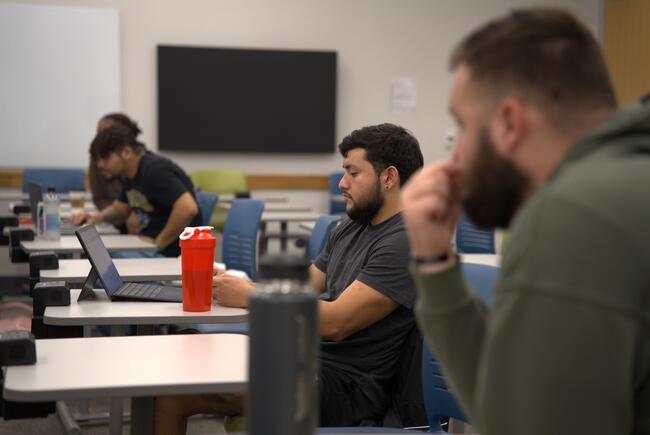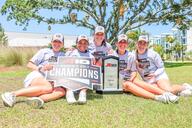You have /5 articles left.
Sign up for a free account or log in.

UTSA enrolls a large population of military-affiliated students, including ROTC cadets and veterans.
University of Texas at San Antonio
Over 820,000 undergraduates are connected to the U.S. military, including those who are actively serving or enlisted in the National Guard, former service members and spouses, or dependents of military service members.
The University of Texas at San Antonio, located in Military City USA, serves over 5,000 military-affiliated students, including veterans, service members and their families, in a region that has the largest concentration of military bases in the country.
In the most recent episode of Voices of Student Success, host Ashley Mowreader speaks with Michael Logan, UTSA’s senior director for veteran and military affairs and a U.S. Marine Corps veteran, about supporting military-affiliated students through their transition into higher ed and the role of community in student veteran retention.
An edited version of the podcast appears below.
Q: Can you set the playing field for people who might not be familiar with San Antonio and the region and how that impacts your military-affiliated students?

Michael Logan, senior director for veteran and military affairs.
University of Texas San Antonio
A: It’s interesting, because the branding of the city, or the trademark, is Military City USA, and that’s not hyperbole when you consider not just the active-duty components that are here, but how many veterans retire to this area.
It’s not just the folks that are here because [the Department of Defense] is making them be here, but it’s a destination. In the county alone, there are about 100,000 veterans. If you expand into the Alamo area, Council of Governments region, it gets up to about 250,000 veterans. So you have to think, it’s not just the veterans, it’s the veterans’ spouses, all the dependents, all the family members. And so the number is probably three times that that we’re actually serving.
Q: That’s crazy, just the sheer number of people. I wonder if you can tie into this population of military-affiliated students at the university. Obviously you have veterans and then those, like you mentioned, family members, dependents. But then there’s also students who are currently engaged in the military.
A: You’ll notice if you look at our website, we lean away from using “veteran” in our terminology even in our center for military-affiliated students, and that’s intentional. Because we have so many different military-connected students that are not specifically in that veteran category. We do have a lot of National Guard and military reserve members; we do have a lot of activity duty. In fact, the family members probably outnumber the veterans and active duty two to one.
So for us, it was very important that the entire military-connected population understood that we were here to support everybody and not just that narrow swath of just those who had previously worn the uniform.
Q: When we are thinking about those students who are associated more directly with military service, so student veterans, ROTC or currently enlisted, can you talk a little bit about some of those challenges or opportunities when military-affiliated learners engage with higher education and how they look different from maybe your traditional learner on campus?
A: That’s a very good question, and I learn something every day, too. Even as someone who did time on active duty, I wasn’t doing those things simultaneously.
But what’s very interesting to me is having to articulate to folks who are not vets or not military-connected that military is a culture. So when we’re talking about validating everybody’s experiences in the classroom and making sure that we’re digging into the full richness and depth of experiences to really give everyone the best possible collegiate experience, we can’t discount military service as a separate and distinct culture.
I think what has happened previously is that there was concern where maybe a student was reframing things they were learning in their military context, and the instructor might have been thinking, “Well, you’re not getting it. I’m trying to get you to think this certain way, but you keep defaulting it back to your military context.” And then that leads to a conversation that I’ll eventually have with the instructor that talks about, “Well, the reason why this is happening is because categorically and demonstrably military service is a culture.”
I actually did research on that back in 2019, and again in 2024, we did a quantitative study. I did it with some student veterans who were graduate students here at the university, where we were able to empirically demonstrate that veteran itself is a culture.
You are all your intersectional identities, but once you’ve served and once you’ve had that military service experience, you experience all of those pieces of yourself through the lens of that military service. And so of course, when you’re teaching somebody something, when they contextualize it, it’s going to be through the lens that they see everything else, including their own identity.
Q: I’m the daughter of two veterans, and it’s funny, I remember being in high school, and the word “squad” was really trendy with young people at that time, and my mom was like, “Squad? That’s a military term. Like, what do you mean, your squad? Like, your squadron? What’s happening?” Even in the daily words that we use, there’s this affiliation that’s always going to come back to people.
So when we talk about supporting students that are military affiliated on campus, can you walk us through some of the programs and offerings that you all have?
A: There’s many, and some of them are more focused on traditional academic outcomes; we’ve got resources specific for individual tutoring.
We recognize that we have a very large relative population of veterans using what’s called veteran readiness and employment, which means they’re disabled veterans. We have over 430 of those on our campus, so we have more just from that group than most campuses have veterans. So we’re very intentional about providing services that are, first of all, diverse enough to cover all the different conditions, visible and invisible, that might be barriers to success academically.
The activities that I’m most proud of are the ones that are more impactful and [contribute] directly toward sense of belonging and community building. Because I think if you don’t have a strong sense of belonging, and you don’t have a visible and established community, then you’re not going to get true engagement. You’re just going to get a veteran or a family member that shows up, goes to the class, absorbs the information, goes home, but they’re not really engaging with their peers on campus, or campus culture. They’re not getting the other 50 percent of why you go to college, which is to develop social capital and be exposed to ideas that are new and different than your own.
Some of the programs that we’ve put together on that front are something we call Coffee With Vets, which is a very informal mixer that we do every second Wednesday of the month. When I say Coffee With Vets, you’ll notice I didn’t say with student vets, right? Because it’s for the entire veteran community. We have over 200 employees that wore the uniform as well, and it’s not uncommon to see students, employees, people from the community, stakeholders, that use that event as an opportunity to just be seen and get to know people.
I think what we’re guilty of, myself included, is that a veteran might look at a resource and think, “I don’t need that today, so it’s not relevant to me,” and then when they do need it, then there’s this issue with trust: “I’m only going to engage with something I trust.” And so Coffee With Vets is an opportunity for someone like me to maybe engage with VA [U.S. Department of Veterans Affairs] staff. And even though I may not need what they’re doing right now, I may need it in six months or a year, and I’m going to remember that person that I commiserated with over a bacon-covered doughnut and some Black Rifle coffee. I’m much more willing to engage in whatever that support is.
That’s just one example. And the reason why we do that, the reason why we emphasize community building and building that trust is because when you look at some of the barriers to completion and matriculation, a lot of them are vets putting something off or not engaging with something. So if we can minimize hesitation and maximize trust, then we can get those vets to fully utilize the wraparound services that we provide and ultimately be successful, not just in school, but beyond school, because they’re only here for a little while. And what we’re trying to do is set them up for success in the future.
Q: I’m so glad that you mentioned that role of helping students see that resources might be useful later on. Because one of the common barriers that we hear from student veterans is that the military is so structured and that there’s so much told to them about what your next step is and where you’re going to go and what your job is, that when you come to higher ed, you really have to find a sense of self-advocacy and start finding things on your own that might just be unfamiliar or different.
I love that you all provide a space for students to explore but also be connected with people who think like they do and understand that it might be a totally different culture change to have somebody like you have to ask for help sometimes.
A: The two things you bring up are advocacy and what I like to call cultural considerations. I don’t like to say cultural competency, because that implies incompetency. It’s not incompetency, it’s just cultivated.
Advocacy is a big thing. There’s a significant amount of my time spent doing that, sometimes at the request of veterans, sometimes not. Sometimes it’s because I need to help the veteran figure out how to learn to live in the world that they’re in now. But it’s not uncommon for me to have a veteran reach out and say, “I want to have this conversation with an instructor, but I don’t know how to do it without coming across as just super aggressive or knife handing or using the F-word as a comma,” which sometimes they’re still in the habit of doing. But they’re self-aware, right? So they’re coming in, they’re asking, “I don’t want the message to get lost in how I’m delivering it. So please help me.” And we’ll do that.
But the other side of that is also the self-advocacy piece, which I’m glad you mentioned, too, because there’s just, like you said, when you’re on active duty, there’s somebody who’s responsible for you. As you mentioned, you’ve got a squad leader, you’ve got a battle buddy, you’ve got somebody, even when you check into a base, somebody walks you around and shows you everything. And that’s just not the case in higher ed.
You may not know what Student Disability Services is. You may not know that if you have a 50 percent or higher [disability] rating, you get free [ADA] surface parking. So here you are paying for it. Or testing accommodations—just all these different things that vets are leaving on the table, and it’s hurting them in some form or fashion, because they’re not able to maximize their potential.
It’s a weird tightrope where we’re trying to figure out, “How do we give them all this information, but in a way where it’s not like sipping water from a fire hose or this is going to be information dumped five minutes later?” We have to be very, very intentional about parceling out that information.
We kind of do it in layers. First, here’s who we are, then if you have an interest in these things categorically, and then it eventually it gets into the into the weeds of things. But that’s actually been very successful for us.
As a matter of fact, we asked some of our vets, “Hey, what do you wish you would have known the first day, now that you’re here towards the end, what do you wish you would have known?” And they actually put together a booklet that has everything that they all said: “Here’s what would have been super helpful on day one to know.” So now that’s turned into something that our student vets maintain.
My transition off of active duty was—I’m going to date myself here—over 20 years ago, probably over 25 years ago. My experiences and my needs are very, very different than a service member becoming a veteran in the year 2025. So it’s very important that we maintain that close connection with these subsequent cohorts of veterans that are showing up on our campus and giving them the agency to drive—“Here’s the information we need, so hey, please provide it.”
That requires a lot of psychological safety on behalf of my staff, because you get that thought about, “if it ain’t broke, don’t fix it.” But at the same time, something that was relevant two years ago may not be relevant to the folks that are getting out in a very different environment.
Q: You touched on this a little bit earlier, but I think just having that staff that has military experience or military affiliation as well can be really helpful. And like you said, translating to higher education, but also understanding, like, even if it’s not right now, what service members might need, but having a little bit of empathy for that circumstance and what they might be transitioning through.
A: I agree with that 100 percent. All of the staff members that I have today in summer of ’25 I had in fall of 2018, every single one of them. I haven’t lost anybody through COVID—if you’re in Texas, Snowvid—or the great resignation.
I think that is a very clear indicator of the orientation of my staff. We’re all military connected, either veterans or family members themselves, and they’re here because the work that we do here is what fills our cup.
As a matter of fact, we have a purpose statement that is taped up everywhere, and it’s derived from an old story about President Kennedy visiting NASA. He sees a janitor, and he asks the janitor, “Hey, what do you do here?” And the janitor says, “I’m helping put someone on the moon.”
We’ve adapted that, and if you were to walk into UTSA Center for Military Affiliated Students and you see somebody shredding paper or filing or helping a student all across the range of things we could be doing, and you ask them, “Hey, what are you doing here?” The answer is going to be “I’m trying to provide a level of support for students that I wish I would have had for myself.”
Q: I wanted to talk a little bit about careers, because military students often come in with lots of life and career experience, but often enter higher education as a pivot or as an exploration of doing something else. I wonder if you can talk about navigating that space and understanding where higher education is a bridge for military-affiliated students.
A: That’s a tricky one in that you’re right, some of them come in and that pivot sometimes is intentional. If you look at our chief information officer [Kendra Ketchum], who was a Navy corpsman, and then postmilitary pivoted into, she’s our CIO.
But I think what’s very important when trying to help a service member navigate what they’re going to do with their higher education experience is you have to ask almost the five whys. If you’re familiar with Lean, you know what the five whys are. If you have a toddler, you know what five whys are.
But if you ask a vet, “Hey, why are you here?” The first answer you’re probably going to get is, “Because you’re supposed to use the GI Bill.” That’s what you’re told. You leave active duty, you go to college, you use the GI Bill.
“So what do you want to get out of it?”
“I wanted to get a degree and get a good job.”
But really, what it comes back to is trying to get them to be reflective on who it is you want to be, rather than what it is you want to do. What we uncover is that most veterans are looking for two things: to continue serving and community.
So once we figure out what that piece is for them, it’s a lot easier to guide them through the process and not just tell them all, “Here’s the major you should take, or which classes or which instructor,” but actually provide opportunities for academic inquiry.
I mentioned earlier that we did research for sense of belonging and identity. It started years ago when a veteran came to me, and she was frustrated because she had this great idea for doing a study to create a rubric based on positive psychology to figure out what motivates a veteran, what makes them tick, what fills their cup. Because she wanted to focus on that, not on the deficit discourse: What’s wrong with you and how do we address your problem today?
She had gone to different places and couldn’t get any traction because nobody was studying that; that wasn’t a topic that anyone was researching. And I said, “Well, I’m not a psychologist, but I’ll do everything I can to help you.”
Fast-forward to the end of that story: She did the study, and then she got accepted to two national conferences to talk about it, and she graduated with her master’s in social work and has returned to our university as an internship coordinator to start our first-ever veteran case management program. We’re going to pilot it under her watch. She invented the rubric.
That’s one example and I can give you many more. But again, it’s very nontraditional. We’re not just talking about advising students, we’re talking about providing opportunities for students to develop and cultivate their inquiry so they don’t lose that through the college process and then end up being something other than what they intended when they graduate.
Q: Regarding sense of belonging, I think it’s natural for student veterans to fall in step with each other. But then there’s also the wider campus community and finding that sense of belonging just on campus as well. I wonder if you can talk about those two avenues, one connecting like-minded, military-affiliated students, and the other encouraging them to get out, explore and see what else the campus has to offer?
A: That’s an excellent point, and it is a strange kind of rut that we fall into where we want to gravitate towards what we know. We show up on a campus and everything’s weird, and people are different, and so we’re looking for other people that are like us, and that’s kind of missing the point.
What I do to try and encourage engagement outside of just vets hanging out with vets is I will encourage vets to cultivate the thing that they want to keep doing, which is continue serving, but expand that vision beyond vets.
For example, our local Student Veteran Association chapter, they were doing a lot of programming that was vet-focused, vet-centric. And I said, “You know who doesn’t have a lot of support on this campus is military family members, like the kids in the center for military families. So maybe we connect with them and we look for a broader opportunity to support where there’s a gap.”
We had vets that would ask me, “How come I’m having trouble getting nonvets to see the value in us, or not look at us sideways or appreciate our presence in the classroom?” And I said, “Well, why don’t we look at service projects that benefit them, and not necessarily just y’all?”
So a group of vets got together, and they came up with this great idea to provide golf cart shuttle service for folks with mobility issues. It was the vet group that was like, “All right, we’re going to write the grant, we’re going to get the golf cart, we’re going to drive it, but it’s going to be available to anyone who’s got any kind of mobility issue.” They didn’t even say disability, just mobility. It could be a sprained ankle.
And it’s a service that they were going to leverage their capital. Because vets can go and they can ask for these things and get these donations, but [they] make it available to the entire campus population and that lines up exactly with their values. They enlisted to serve, and they served folks. This was kind of a microcosm of that.
It’s great to see how, when they’re thinking it through and they’re ideating, all of a sudden, that light bulb goes off, and it makes sense that we don’t have to circle the wagons because we’re in a strange environment. What we need to do is do what we’ve always been doing and leverage everything that we bring to the table to lift everyone else around us.
Q: You’re a veteran and a veteran in this space in higher education. For those who might be unfamiliar with working with military-affiliated students or looking to do more on their campus to support these students, what’s a point or two you would give for someone who wants to do better?
A: First and foremost, I think that there might be a misconception out there that vets maybe see themselves as apart from or maybe even above [others]. You hear about Billy Madison syndrome: “I’m older and I know more things.”
While that might be true for some vets, vets are typically not looking for differential treatment—especially in the classroom or among their peers or from instructors or even from staff; they’re just looking for their experiences to be as validated as anybody else’s. So it’s very important that we’re aware that there are some things we can do and say that will be received as microaggressions. The issue is, when a vet experiences a microaggression, they don’t get aggressive. I think some people think, “Oh, man, they’re about to snap and lose their minds,” and that’s not what they’re going to do. What the vet’s gonna do is absolutely shut down, and they will disengage, and you will have lost any opportunity going forward to regain their trust and to have them feel a part of the community.
So first and foremost, just if one could shift their mindset and understand veteran [experiences] is a culture, and think of it as any other culture you support on campus. No. 1, that’s going to help you as the nonvet to really inform your perspective.
Then second of all is listen and don’t be prescriptive. And that applies not just for nonvets, but for people like me as well. Like I mentioned, my [military] experience was a long time ago versus what people are experiencing now. And as much as I’m tempted all the time to say, “I know what you’re going to need, I know what’s going to happen to you in six months and in two years, and the stages of going from active duty to civilian and the wall you’re going to hit. I know all these things are coming, so I’m going to set all these things up, and I’m gonna expect you to do them.” Every vet is sitting there saying, “Oh, that’s not me. You don’t know me.” And I know, because I was that guy that did the same thing.
It’s important to kind of push down my own impulses and stay very, very actively engaged and just constantly ask, “What is it you need? What is it I can do to support you?” By doing that, you’re building that trust, so that when those other [challenges] inevitably do happen, you don’t have to go find them and save them from it. They’re going to come to you and ask you, “Hey, can you help me through it?”
That’s the difference between, I think, being effective and going through the motions, is when they’re asking for it and they want to engage with it. But those are the two biggest things. Vets aren’t all that different. They’re just actually, weirdly, looking to be part of the crowd.
Get more content like this directly to your inbox. Subscribe here.




